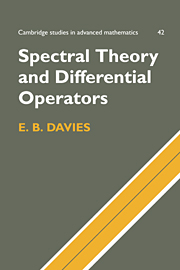4 - The variational method
Published online by Cambridge University Press: 08 January 2010
Summary
Classification of the spectrum
In this chapter we investigate the spectral properties of abstract selfadjoint operators in more detail, making use of the spectral theorems (Theorems 2.3.1 and 2.5.1). In contrast with Chapter 3, we focus mainly on abstract situations in which the spectrum of a self-adjoint operator consists simply of isolated eigenvalues of finite multiplicity. Several classes of operators of this type are studied in later chapters. We use the notation of Theorem 2.5.1 freely within this section, but frequently suppress explicit reference to the unitary operator U of that theorem. Many of the considerations of this chapter become trivial or do not make sense if the Hilbert space ℋ is finite-dimensional, so we assume throughout that it is infinite-dimensional. We assume as always that ℋ is separable, or equivalently that any complete orthonormal set is countable.
The following lemma from measure theory will be important.
Lemma 4.1.1Let μ be a finite measure on RN, and let E be a Borel subset of RN. Then the space L := L2(E,dμ) has finite dimension m if and only if there are m distinct points x1, …,xm in E of positive measure such that E\Umr=1 {xr} has zero measure.
Proof If such points exist then it is clear that L has a basis consisting of the characteristic functions of these points. Conversely suppose that L has finite dimension m. For any integer r ≥ 1 we can partition RN into a countable number of cubes C(r,s), 1 ≤ S < ∞, with edge length 2−r; we take these cubes to be in standard position, that is every coordinate of every vertex of C(r,s) is of the form t/2r where t is an integer;…
- Type
- Chapter
- Information
- Spectral Theory and Differential Operators , pp. 72 - 98Publisher: Cambridge University PressPrint publication year: 1995

